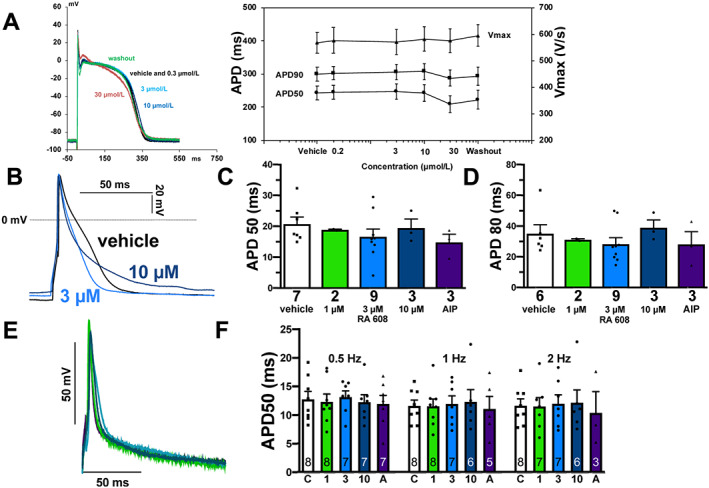Figure 3.

RA608 did not affect action potential characteristics. (A) Left panel: original registrations of APs elicited in isolated Purkinje fibres (n = 3 rabbits) at 1 Hz. There was no notable effect of RA608 exposure on AP shape and characteristics. Right panel: mean ± SEM for AP duration at 50% or 90% repolarization (APD50 and APD90), or maximal AP upstroke velocity (V max, n = 3 rabbits, each). (B) Original recordings of APs elicited in isolated human atrial cardiomyocytes. Mean ± SEM data for APD50 (C, patients: vehicle n = 7; 1 μM RA608 = 2, 3 μM RA608 = 9, and 10 μM RA608 = 3; and AIP = 3) or APD80 (D, patients: vehicle n = 6; 1 μM RA608 = 2, 3 μM RA608 = 9, and 10 μM RA608 = 3; and AIP = 3) for vehicle, 1, 3, and 10 μM RA608, and AIP indicated that there was no significant effect of RA608 or AIP on AP duration. (C, D) Dunnett's test for RA608 vs. vehicle following a one‐way ANOVA; AIP vs. vehicle using Student's t‐test. (E) Original recordings of APs elicited in murine ventricular cardiomyocytes. (F) Mean ± SEM data for APD50 (n in the bars = cells, five mice) upon control (C), RA608 (1 = 1 μM, 3 = 3 μM, and 10 = 10 μM), or 2 μmol/L myristoylated AIP (A) show that there was no significant effect of RA608 or AIP on AP duration (two‐way ANOVA followed by Tukey's post‐test).
